Scientific name
Aphanogmus fijiensis (Ferrière) (=Calliceras fijiensis Ferrière, Ceraphron fijiensis (Ferrière))
Taxonomic position
Hymenoptera: Ceraphronoidea: Ceraphronidae
Diagnosis
Body 1.2 mm. More or less fully black, antennae geniculate, with scape reddish or yellowish brown, remaining segments dark brown, apical segments, including club, darker; legs reddish / yellowish brown; abdomen shiny, blackish. Compound eyes with very short hairs. Antennae inserted very close to the mouth margin, 11-segmented, conspicuously hairy and without a clearly demarcated club in male, 10-segmented with a prominent club, apical segment of club nearly equal to previous two segments in
female. Fore wing with curved stigmal vein. Abdominal tergite 2 longest, reaching beyond middle of abdomen. Commonly collected as a hyperparasitoid of several pests.
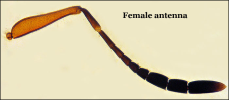
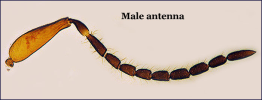
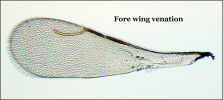
Dessart (1971) provided a key to the species. Polaszek (1998) keyed the species and illustrated the male genitalia. Images
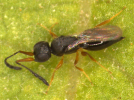
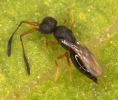
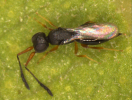 Adult, dorsal view Adult, dorsal view
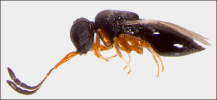 Adult, lateral view Adult, lateral view
Distribution
Widely distributed in the Oriental and Afrotropical regions; West Indies.
Hosts / Biology
Commonly collected as a hyperparasitoid, occasionally as a primary parasitoid, on a variety of hosts. Associated with several lepidopterous pests such as cereal stem borers, mainly as hyperparasitoids of bethylid, braconid and ichneumonid primary parasitoids (Polaszek, 1998).
References
- Dessart, P. 1971. Transferts generiques de queiques Ceraphronidae (Hym. Ceraphronoidea). Bulletin et Annales de la Societe Royale Belge d'Entomologie 107: 94-100.
- Ferriere, C. 1933. Chalcidoid and proctotrupoid parasites of pests of the coconut palm. Stylops, 2:
86-108.
- Polaszek, A. 1998. 18. Ceraphronidae, pp. 187-189. In: African cereal stem borers: economic
importance, taxonomy, natural enemies and control. CAB International, Wallingford, UK. 530 p.
|